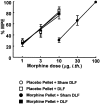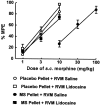Tonic descending facilitation from the rostral ventromedial medulla mediates opioid-induced abnormal pain and antinociceptive tolerance
- PMID: 11150345
- PMCID: PMC6762454
- DOI: 10.1523/JNEUROSCI.21-01-00279.2001
Tonic descending facilitation from the rostral ventromedial medulla mediates opioid-induced abnormal pain and antinociceptive tolerance
Abstract
Many clinical case reports have suggested that sustained opioid exposure can elicit unexpected, paradoxical pain. Here, we explore the possibility that (1) opioid-induced pain results from tonic activation of descending pain facilitation arising in the rostral ventromedial medulla (RVM) and (2) the presence of such pain manifests behaviorally as antinociceptive tolerance. Rats implanted subcutaneously with pellets or osmotic minipumps delivering morphine displayed time-related tactile allodynia and thermal hyperalgesia (i. e., opioid-induced "pain"); placebo pellets or saline minipumps did not change thresholds. Opioid-induced pain was observed while morphine delivery continued and while the rats were not in withdrawal. RVM lidocaine, or bilateral lesions of the dorsolateral funiculus (DLF), did not change response thresholds in placebo-pelleted rats but blocked opioid-induced pain. The intrathecal morphine antinociceptive dose-response curve (DRC) in morphine-pelleted rats was displaced to the right of that in placebo-pelleted rats, indicating antinociceptive "tolerance." RVM lidocaine or bilateral DLF lesion did not alter the intrathecal morphine DRC in placebo-pelleted rats but blocked the rightward displacement seen in morphine-pelleted animals. The subcutaneous morphine antinociceptive DRC in morphine-pelleted rats was displaced to the right of that in placebo-pelleted rats; this right shift was blocked by RVM lidocaine. The data show that (1) opioids elicit pain through tonic activation of bulbospinal facilitation from the RVM, (2) increased pain decreases spinal opioid antinociceptive potency, and (3) blockade of pain restores antinociceptive potency, revealing no change in antinociceptive signal transduction. These studies offer a mechanism for paradoxical opioid-induced pain and allow the development of approaches by which the loss of analgesic activity of opioids might be inhibited.
Figures







Similar articles
-
Cholecystokinin in the rostral ventromedial medulla mediates opioid-induced hyperalgesia and antinociceptive tolerance.J Neurosci. 2005 Jan 12;25(2):409-16. doi: 10.1523/JNEUROSCI.4054-04.2005. J Neurosci. 2005. PMID: 15647484 Free PMC article.
-
Sustained morphine exposure induces a spinal dynorphin-dependent enhancement of excitatory transmitter release from primary afferent fibers.J Neurosci. 2002 Aug 1;22(15):6747-55. doi: 10.1523/JNEUROSCI.22-15-06747.2002. J Neurosci. 2002. PMID: 12151554 Free PMC article.
-
Is paradoxical pain induced by sustained opioid exposure an underlying mechanism of opioid antinociceptive tolerance?Neurosignals. 2005;14(4):194-205. doi: 10.1159/000087658. Neurosignals. 2005. PMID: 16215302 Review.
-
Neurophysiological response properties of medullary pain-control neurons following chronic treatment with morphine or oxycodone: modulation by acute ketamine.J Neurophysiol. 2020 Sep 1;124(3):790-801. doi: 10.1152/jn.00343.2020. Epub 2020 Aug 5. J Neurophysiol. 2020. PMID: 32755331
-
Induction of pain facilitation by sustained opioid exposure: relationship to opioid antinociceptive tolerance.Life Sci. 2003 Jun 27;73(6):783-800. doi: 10.1016/s0024-3205(03)00410-7. Life Sci. 2003. PMID: 12801599 Review.
Cited by
-
The long-term effects of repeated heroin vapor inhalation during adolescence on measures of nociception and anxiety-like behavior in adult Wistar rats.Psychopharmacology (Berl). 2022 Dec;239(12):3939-3952. doi: 10.1007/s00213-022-06267-6. Epub 2022 Oct 26. Psychopharmacology (Berl). 2022. PMID: 36287213 Free PMC article.
-
Primary afferent NMDA receptors increase dorsal horn excitation and mediate opiate tolerance in neonatal rats.J Neurosci. 2006 Nov 15;26(46):12033-42. doi: 10.1523/JNEUROSCI.2530-06.2006. J Neurosci. 2006. PMID: 17108177 Free PMC article.
-
Direct Effect of Remifentanil and Glycine Contained in Ultiva® on Nociceptive Transmission in the Spinal Cord: In Vivo and Slice Patch Clamp Analyses.PLoS One. 2016 Jan 15;11(1):e0147339. doi: 10.1371/journal.pone.0147339. eCollection 2016. PLoS One. 2016. PMID: 26771515 Free PMC article.
-
TRPV1 receptor in expression of opioid-induced hyperalgesia.J Pain. 2009 Mar;10(3):243-52. doi: 10.1016/j.jpain.2008.07.004. Epub 2008 Sep 6. J Pain. 2009. PMID: 18774343 Free PMC article.
-
Cold nociception as a measure of hyperalgesia during spontaneous heroin withdrawal in mice.Pharmacol Biochem Behav. 2024 Feb;235:173694. doi: 10.1016/j.pbb.2023.173694. Epub 2023 Dec 20. Pharmacol Biochem Behav. 2024. PMID: 38128767 Free PMC article.
References
-
- Ali NM. Hyperalgesic response in a patient receiving high concentrations of spinal morphine [letter]. Anesthesiology. 1986;65:449. - PubMed
-
- Arner S, Rawal N, Gustafsson LL. Clinical experience of long-term treatment with epidural and intrathecal opioids–a nationwide survey. Acta Anaesthesiol Scand. 1988;32:253–259. - PubMed
-
- Bederson JB, Fields HL, Barbaro NM. Hyperalgesia during naloxone-precipitated withdrawal from morphine is associated with increased on-cell activity in the rostral ventromedial medulla. Somatosens Mot Res. 1990;7:185–203. - PubMed
-
- Bian D, Ossipov MH, Ibrahim M, Raffa RB, Tallarida RJ, Malan TP, Jr, Lai J, Porreca F. Loss of antiallodynic and antinociceptive spinal/supraspinal morphine synergy in nerve-injured rats: restoration by MK-801 or dynorphin antiserum. Brain Res. 1999;831:55–63. - PubMed
-
- Castiglioni AJ, Gallaway MC, Coulter JD. Spinal projections from the midbrain in monkey. J Comp Neurol. 1978;178:329–346. - PubMed
MeSH terms
Substances
LinkOut - more resources
Full Text Sources
Medical
